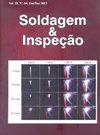基于傅里叶变换和局部二值模式算法的搅拌摩擦焊接接头表面质量分析
IF 0.3
4区 材料科学
Q4 METALLURGY & METALLURGICAL ENGINEERING
引用次数: 1
摘要
摘要:搅拌摩擦焊是一种先进的固态连接工艺,在汽车、制造业、航空航天和铁路等行业都有广泛的应用。刀具转速、焊接速度、轴向力和倾斜角度等输入参数决定了搅拌摩擦焊接接头的质量。这些参数选择不当,进一步导致制造质量差的接头,从而产生凹槽边缘,闪光形成和各种其他表面缺陷。本文采用基于纹理的局部二值模式(LBP)分析机器学习算法和傅立叶变换算法对不同转速下焊接的搅拌摩擦焊接接头进行纹理特征提取。结果表明,LBP算法可以准确地检测出搅拌摩擦焊接头表面的不规则性,傅里叶变换方法可以检测出搅拌摩擦焊接头表面的常规边缘。在实例研究中,利用傅里叶变换方法构建了基于图像的缺陷识别系统。使用了理想滤波器、巴特沃斯滤波器、低通滤波器、高斯滤波器和高通滤波器五种类型的滤波器。结果表明,与其他四种滤波器相比,高通滤波器具有更强的边缘检测能力。与高斯滤波器和巴特沃斯滤波器相比,理想滤波器有很多失真本文章由计算机程序翻译,如有差异,请以英文原文为准。
Surface Quality Analysis of Friction Stir Welded Joints by Using Fourier Transformation and Local Binary Patterns Algorithms
https://doi.org/10.1590/0104-9224/SI25.27 Abstract: Friction Stir Welding process is an advanced solid-state joining process which finds application in various industries like automobiles, manufacturing, aerospace and railway firms. Input parameters like tool rotational speed, welding speed, axial force and tilt angle govern the quality of Friction Stir Welded joint. Improper selection of these parameters further leads to fabrication of the joint of bad quality resulting groove edges, flash formation and various other surface defects. In the present work, a texture based analytic machine learning algorithm known as Local Binary Pattern (LBP) and Fourier transformation algorithm are used for the extraction of texture features of the Friction Stir Welded joints which are welded at a different rotational speed. It was observed that LBP algorithm can accurately detect any irregularities present on the surface of Friction Stir Welded joint and Fourier transformation method can detect the groovy edges present on the Friction Stir Welded joint. In the case study, an image based defect recognition system by using Fourier transformation method is constructed. Five types of filters i.e. Ideal Filter, Butterworth Filter, Low pass Filter, Gaussian Filter and High Pass Filter were used. The results showed that the high pass filter has more capability to detect the edges in comparison to other four filters. It was also observed that Ideal filter has a lot of distortions when compared to the Gaussian Filter and Butterworth
求助全文
通过发布文献求助,成功后即可免费获取论文全文。
去求助
来源期刊

Soldagem & Inspecao
工程技术-冶金工程
CiteScore
1.00
自引率
16.70%
发文量
13
审稿时长
12 weeks
期刊介绍:
The Journal Soldagem & Inspeção (S&I) js a techno-scientific journal created in 1995. Printed issues of this journal are distributed free of charge to libraries in Brazil, Latin America and the Iberian Peninsula. It has been printed regularly every quarter since September, 2002, and, since the beginning of 2007, its electronic version is available in the address: (http://www.abs-soldagem.org.br/s&i/). The journal is sponsored by the Brazilian Welding Association (ABS).
Since its creation several well known professionals working in welding contributed with the Journal Soldagem & Inspeção and its editorial board crosses the Brazilian borders. During its evolution the Journal received ta special contribution from the Editors-in-chief : Ronaldo Paranhos, Américo Scoti, Paulo Modenesi e Alexandre Bracarence. Since January 2012 the Editor-in-chief is Ana Sofia C. M. D’Oliveira, Full professor at Universidade Federal do Paraná (UFPR) . Her work focus mainly on Hardfacing and Physical Metallurgy. The jornal Soldagem & Inspeção also counts with 10 Associate Editors and a fix Editorial board of referees. short-term (Ad Hoc) referees can be invited to evaluate some papers submitted to the journal.
The Soldagem & Inspeção journal is the scientific divulgation channel of the Brazilian Welding Association (ABS). It aims to publish original papers related to the scientific and technological development of welding, inspection, and related fields. Review papers or letters on current and controversial subjects are also published in the Journal.
Its abbreviated title is Soldag. insp. (Impr.), which should be used in bibliographies, footnotes and bibliographical references and strips.
 求助内容:
求助内容: 应助结果提醒方式:
应助结果提醒方式:


